Family : Amaryllidaceae

Text © Prof. Giorgio Venturini

English translation by Mario Beltramini
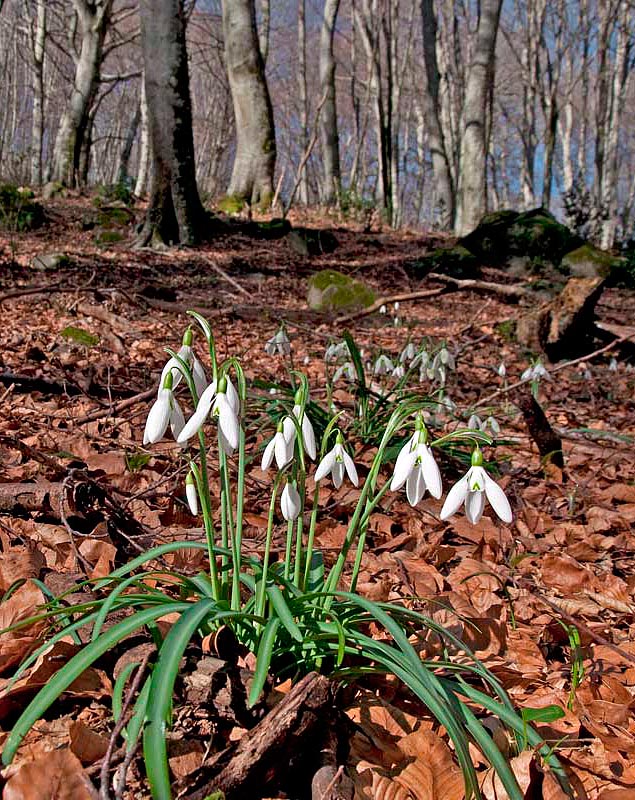
Native to central-southern and Caucasic Europe, Galanthus nivalis is a bulbous perennial geophyte © Venturini
For this reason the flower is the hero of countless legends and popular traditions, besides being the object of many poetries and pieces of music.
To these reasons of interest we must add its numerous and remarkable pharmacological properties.
The genus Galanthus, that includes about 15 species, comes from the Greek gala (γαλα) “milk” and anthos (ανϑος), for the white colour of the flowers.
The species nivalis from the Latin adjective “of the snow”, due to its characteristic of blooming before the snow melts.
Also the vulgar name snow piercer refers to the characteristic of appearing out of the snow.
In various Italian regions are indicated with the term of snow piercer other flowers, such as the Leucojum, the crocus or some white anemones. British vulgar names are: snowdrop, February fairmaids, dingle-dangle, Candlemas bells, Mary’s tapers.
The Galanthus nivalis is a perennial bulbous geophyte, therefore a plant whose perennial organ is a bulb, from which, every year, generate flowers and leaves.
The bulb is oval, of 1-2 cm, brown wrapped by chestnut brown or blackish tunic. Erect stems, 10-30 cm, arcuate on top, slightly streaked. Leaves all radical, the outer ones reduced to 2 membranaceous sheaths wrapping, at the base, the innermost ones, usually nastriform, dark green-glaucous up to 20 cm long, opposite, with rounded apex, with an evident central vein.
Hermaphroditic flowers, solitary, pendulous, covered by an about 3 cm spathe formed by 2 bracts merged up to nearly the apex. Usually they are white, at times yellowish or greenish.
The flower if formed by six tepals with evident longitudinal vein, the outer three ones, entirely white with oval-lanceolate lamina, 1,5-2,5 cm long, the three inner tepals, more or less evidently bilobed, white, with a green spot V-shaped that usually follows the shape of the of the lobes.
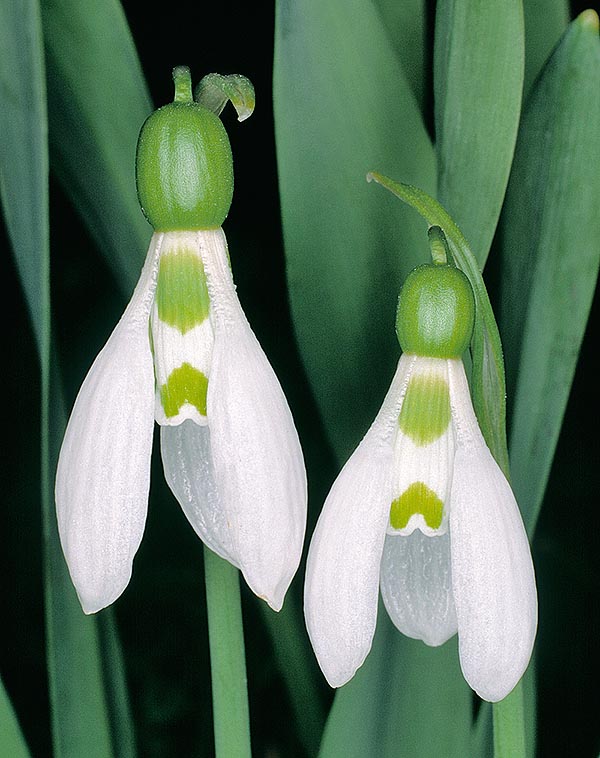
In England, where was introduced since probably the Roman time, in 1950 the snowdrop bloomed by late February, but from 1990, due to climate changes, is already in bud in January © Giuseppe Mazza
The stamina are 6, much shorter than the inner tepals, with whitish filaments shorter than the anthers, yellowish, restricted at the apex; gynoecium formed by a tri-locular, inferior ovary, with single filiform style, greenish, slightly more than the height of the anthers. The flower has a light scent, by some felt as similar to the almonds or to the honey, by others as unpleasant.
The fruit is an oval and fleshy capsule, up to 1,5 cm long, tri-loculate, containing about 10 seeds per loculus; globular (4-4,5 mm long) seeds, brown-dark when ripe, with a fleshy outgrowth, called strophiole, of which the ants are greedy. The dispersion of the seeds is myrmecochorous, that is through the ants that nourish of the strophiole.
Usually, the blooming occurs from February to March. Observations done in the English Botanic Gardens of Kew Gardens suggest that the present climate changes are causing a change in the blooming period of the Galanthus nivalis. Around 1950, in fact, the flowers opened by late February whilst starting from 1990 the blooming occurs already in January.
The sheath-shaped spathe covering the flower protects it while making its way in the ground or in the snow at the moment of the anthesis.
The snowdrop is usually pollinated by the bees, attracted by the nectar produced by the inner tepals. While nourishing, the bee rubs on the stigma, depositing the pollen collected previously from other flowers. It loves cool environments especially hilly-mountainous, in the underwood of broad-leaved trees, shady ravines. Woods, clearings and humid meadows rich of humus, from the plain up to about 2000 m of altitude.
Geographic distribution
Present in most central-southern and Caucasic European regions. In Italy is common everywhere, but in Aosta Valley, Calabria, Sicily and Sardinia. In northern Europe, as well as in North America, the Galanthus nivalis is considered as naturalized. Particularly in England, the species is present in a diffused way, but is considered as imported, after some, in the Roman times, but most probably in a later time. The veterans from the Crimean War (1855-656) imported in England the species Galanthus plicatus that had much diffusion in the gardens.
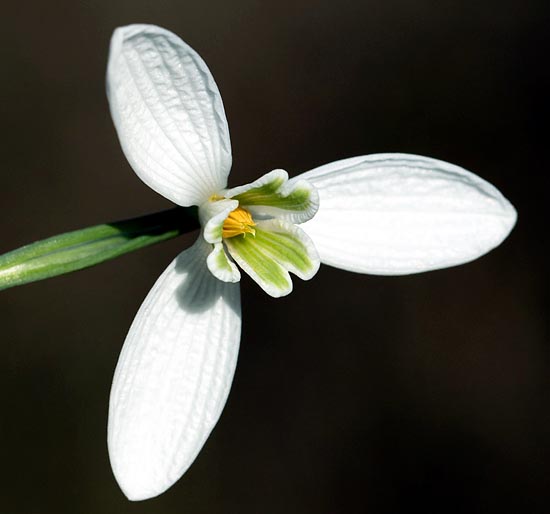
Flower is formed by 6 tepals: 3 large white outer and 3 bilobed with green drawings inner ones © Giorgio Venturini
Similar species in Italy
In northern Italy, up to Tuscany and Marche, in the same habitat of Galanthus nivalis L. is present also Leucojum vernum L. In Calabria and Sicily is present the species Galanthus reginae-olgae Orph. reported also in Tuscany), quite similar to G. nivalis, of slightly bigger size and with late blooming, even autumnal, especially in chestnut woods.
Pharmacological properties
The snowdrop has various important pharmacological and chemical properties, some of which are utilized in practice or are object of research. The main constituents with pharmacological action present in the snowdrop, especially in the bulbs, are some alkaloids like the galantamine (or nivalin), or the lycorine. Are present also some proteins with important chemical activities, that is some lectins (GNA; Galanthus nivalis agglutinin).
The main alkaloid contained in this plant, the galantamine, has a significant effect as inhibitor of the acetylcholinesterase.
The acetylcholinesterase is the enzyme that has the function of inactivating the acetylcholine, one of the most important neurotransmitters, after that this substance has done its function on the nervous or muscular cells. The effects of the galantamine are therefore those of increasing and prolonging in the time the action of the acetylcholine, with a stimulatory effect on the function of the nervous or muscular cells. Due to these properties, the Galanthus nivalis has been used in the traditional medicine of various countries and the galantamine is nowadays utilized in the treatment of dementias such as the Alzheimer’s disease and of other pathologies.
Around the middle of the ‘900 a Bulgarian pharmacologist noted that among the countrymen there was the practice of rubbing flowers of snowdrop on the front to relieve headaches and to administre infusions of the bulbs to the persons suffering from paralysis from polio. Later on the pharmacologists identified substances with anticholinesterasic activity in extracts of Galanthus nivalis, substances that afterwards they identified as galantamine. The drug came into use in Russia as antidote of neuromuscular blocks and in the treatment of various neurological diseases, such as the myasthenia gravis.
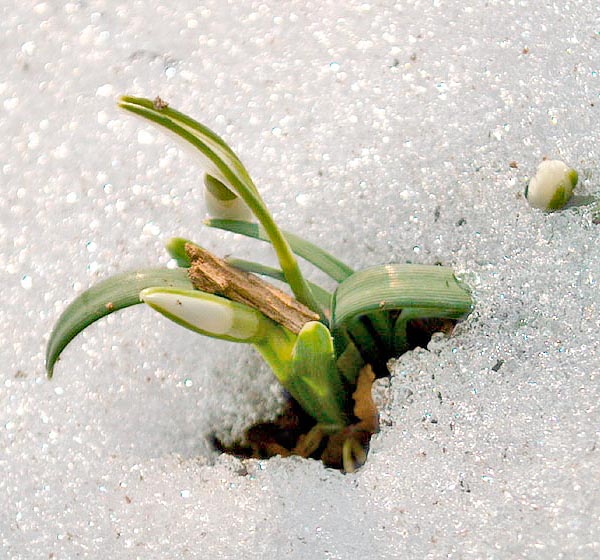
The sheath-shaped spathe covers the flowers and protects it while it gets its way in the soil or in the snow © Giorgio Venturini
The galantamine is also utilized in treating the myasthenia and traumatic injuries of the nervous tissue. The extract of Galanthus nivalis is also emmenagogue, that is a drug that stimulates the menstrual flow and may cause abortion during the first stages of pregnancy.
The pharmacological properties of the snowdrop along with the morphological characteristics and the geographic distribution, have led many scholars to identify in this plant the mysterious Homeric “moly herb”. In the Odyssey the god Hermes gives to Odysseus the plant that will help him from the Circe’s poisonous potions:
“Here, take this potent herb, and go to the house of Circe, and it shall ward off from thy head the evil day ….She will mix thee a potion, and cast drugs into the food; but even so she shall not be able to bewitch thee, for the potent herb that I shall give thee will not suffer it…. So saying, Argeiphontes gave me the herb, drawing it from the ground ….At the root it was black, but its flower was like milk Moly the gods call it, and it is hard for mortal men to dig; but with the gods all things are possible”.
(Homer, Odyssey, Tenth Book, Translation by A.T. Murray).
And so Ulysses escapes the filtres of Circe, who had transformed his companions into pigs (and then slips into her bed). Based on the symptoms appeared in Ulysses’ companions, bewitched by Circe (loss of memory, hallucinations and convinction of having been turned into pigs) it has been suggested that the drug used by the witch might be the stramonium (Datura stramonium), plant used since the old times as basic ingredient pf the witches’ hallucinogenic potions, a powerful anticholinergic drug (which means tyhat it blocks the action of the acetylcholine) that acts on the nervous system. The antidote, capable to antagonize the effect of the stramonium, that is the moly herb had to be anticholinesterasic, just like the Galanthus nivalis. The Datura stramonium as well as the Galanthus nivalis grow in the Mediterranean regions where the Homeric writings are set.
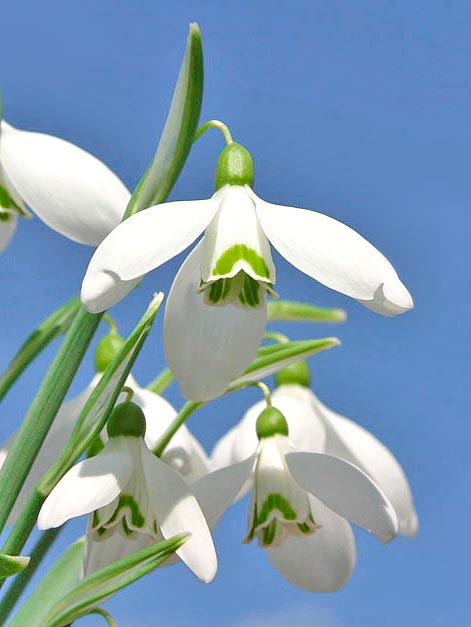
Since old times the hanging flowers announcing the return of spring weeks in advance have hit the human attention and fantasy © Giorgio Venturini
Another substance having pharmacological action contained in the Galanthus nivalis is a lectin, (GNA: Galanthus nivalis agglutinin) that has a broad spectrum of biologic functions as antitumoral, antiviral, antifungal and insecticide, whose possible applications are under study. Its antiviral action in particular, that acts preventing the penetration of the viruses in our cells, has suggested a possible use against the HIV virus.
The lectin of the snowdrop is also an effective insecticide, and can be used against parasites of the orders of the coleopterans, lepidopterans especially caterpillars of butterflies and hemipterans, among which aphids and hoppers (cicadellids). There are underway studies aimed to produce genetically modified plants (GMO) with the introduction of the gene for the lectin of Galanthus nivalis: the first results show that plants expressing the lectin are more resistant towards the parasites. The method might be applied to the tobacco and other plants.
It is important to emphasize that the therapeutical applications of the galantamine must be done under strict medical control and that it is to be excluded any herbalistic use of the plant, due to the presence of lectins and of toxic alkaloids.
Legends and traditions
Probably the oldest myth about the origin of the snowdrop is that related to the fall of Icarus. The myth narrates that Icarus precipitated from his flight on the island of Icaria, where the father Daedalus did bury him. The wind was mourning the death of Icarus and the tears when contacting the ground did transform into a snowdrop. Ikaria is a Geek island close to the Turkish coasts, between Mikonos and Samos almost 300 km far from Crete, where the flight should have begun…. not bad for wings made by feathers attached with wax! It is interesting to remind that in the island of Ikaria has been described a particular species of snowdrop, the Galanthus ikariae, endemic to Ikaria and a few other Aegean islands. For the old Celts the snowdrop was the flower of the celebrations of the fire and especially of the light. These festivals were done in spring, when the days get longer and the light increases, therefore the flower symbolizes the beginning of the spring and the waking up of the life.
Numerous are also the Christian legends concerning the snowdrop. It is told that the creator, after the sixth day, used up the paints (or the fantasy ?), did not know what colour to give to the rain and the snow, that remained colourless. The snow got upset and refused to melt by the end of the winter, covering the world with a colourless mantle.
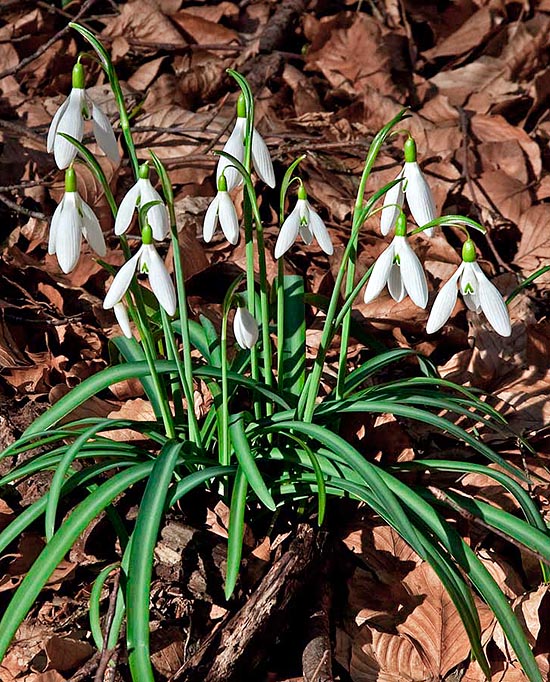
Legends, traditions, tales and poetries have inspired the musicians; but it is also reported as antidote to some poisons, with several uses in the traditional medicine © Giorgio Venturini
It is told that, after having sent away from the Garden of Eden, Adam and Eve wandered on the earth in a harsh winter end Eve was tired and discouraged. An angel, in order to hearten her, transformed some snowflakes in flowers and so the snowdrops were born.
Conversely, a Romanian fairy tale tells that once upon a time the sun had the shape of a nice girl that appeared every year for heating and lighting the world. A year, the monster of winter seized the girl and imprisoned her in his castle, and therefore the world remained without the warmth of the summer. A young man defied the monster of the winter and defeated him, freeing the sun, but was seriously wounded during the battle. Every drop of his blood, falling on the snow, melted it and from the drops the snowdrops were born.
The snowdrop, due to its candid colour and the season of the blooming, is also the flowers of the Feast of the Purification of the Virgin, Febr. 2Nd, or feast of the Candlemas, feast celebrating the end of the winter. After an old habit, on Febr. 2nd the image of the Virgin was taken off from the altar (she was going to purify herself) and in his place was placed a bunch of snowdrops. Usually, the snowdrop is considered as symbol of purity, so much that was diffused the belief that wearing one would induce to honest thoughts.
In the language of the flowers, the snowdrops express sympathy, optimism, virtue and are therefore appropriate also for a bride or for a wedding.
For obtaining the love of the beloved person we have to pick up at dawn some snowdrops freshly sprouted and to throw them in the water. If the current takes them far away, you will get the eternal love, of it takes them back to the bank… it will be better for you to look for another one. Despite being a symbol of spring and consequently of life, in the folklore of many countries, such as Great Britain, the snowdrops strangely enough is also associated to the death and the misfortune. It is possible that this association is connected with the fact that in England the flower seems to have been imported by the monks, who probably planted the bulbs in the graveyards, and this habit continued for a long period. Diffused was the superstition that taking home some cut snowdrops, and especially one single flower, should cause disasters. “To take home a snowdrop transforms the milk in water and does the butter go bad”. Also the hens would lay less eggs or the eggs would not hatch.
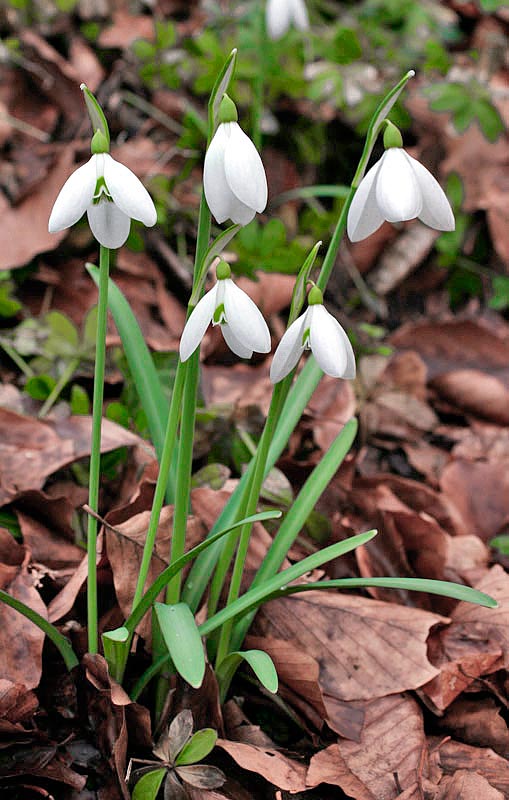
The precious alkaloid of the bulbs of Galanthus nivalis are now studied for various pathologies among which the notorious Alzheimer's desease © Giorgio Venturini
The character of Snow White, in the first English translation of the Brothers Grimm’s fairy tale is named Snowdrop. Elegant and delicate, the snowdrop has inspired many poets, among which S.T. Coleridge, A. Tennyson and W. Wordsworth, or storytellers such as H.C Andersen.
There it stood, so delicate and so easily broken, and yet so strong in its young beauty; it stood there in its white dress with the green stripes. he Snowdrop, H.C.Andersen.
The English romantic poet Wordsworth celebrated the beauty of a small white flower, with these words: “Chaste Snowdrop, venturous harbinger of Spring, and pensive monitor of fleeting years!”.
Tennyson writes: Many, many welcomes, February fair-maid! Ever as of old time, Solitary firstling, Coming in the cold time, Prophet of the gay time, Prophet of the May time, Prophet of the roses.
Also famous musicians got inspired by the snowdrop. Important examples are two lied by Schubert and by Schumann.
Snowdrop, snowdrop, ringing your bells in the meadows, ringing your bells in the silent grove,
(F. Schubert,D 786, “Viola” Text Schober)
La neve che appena ieri a piccoli fiocchi scendeva giù dal cielo, pende oggi come una campanella appesa al delicato stelo (R.Shumann, Testo Ruckert “Il bucaneve”)
Synonyms: Galanthus nivalis var. majus Ten.; Galanthus nivalis var. minus Ten.; Chianthemum nivale (L.) Kuntze; Galanthus imperati Bertol.; Galanthus montanus Schur; Galanthus nivalis var. scharlockii Casp.; Galanthus scharlokii (Casp.) Baker; Galanthus alexandri Porcius; Galanthus umbricus Dammann; Galanthus nivalis subsp. imperati (Bertol.) K.Richt.; Galanthus nivalis var. hololeuca Celak; Galanthus melvillei Voss; Galanthus nivalis f. pictus K.Malý; Galanthus nivalis var. atkinsii Mallett.
→ To appreciate the biodiversity within the AMARYLLIDACEAE family please click here.
